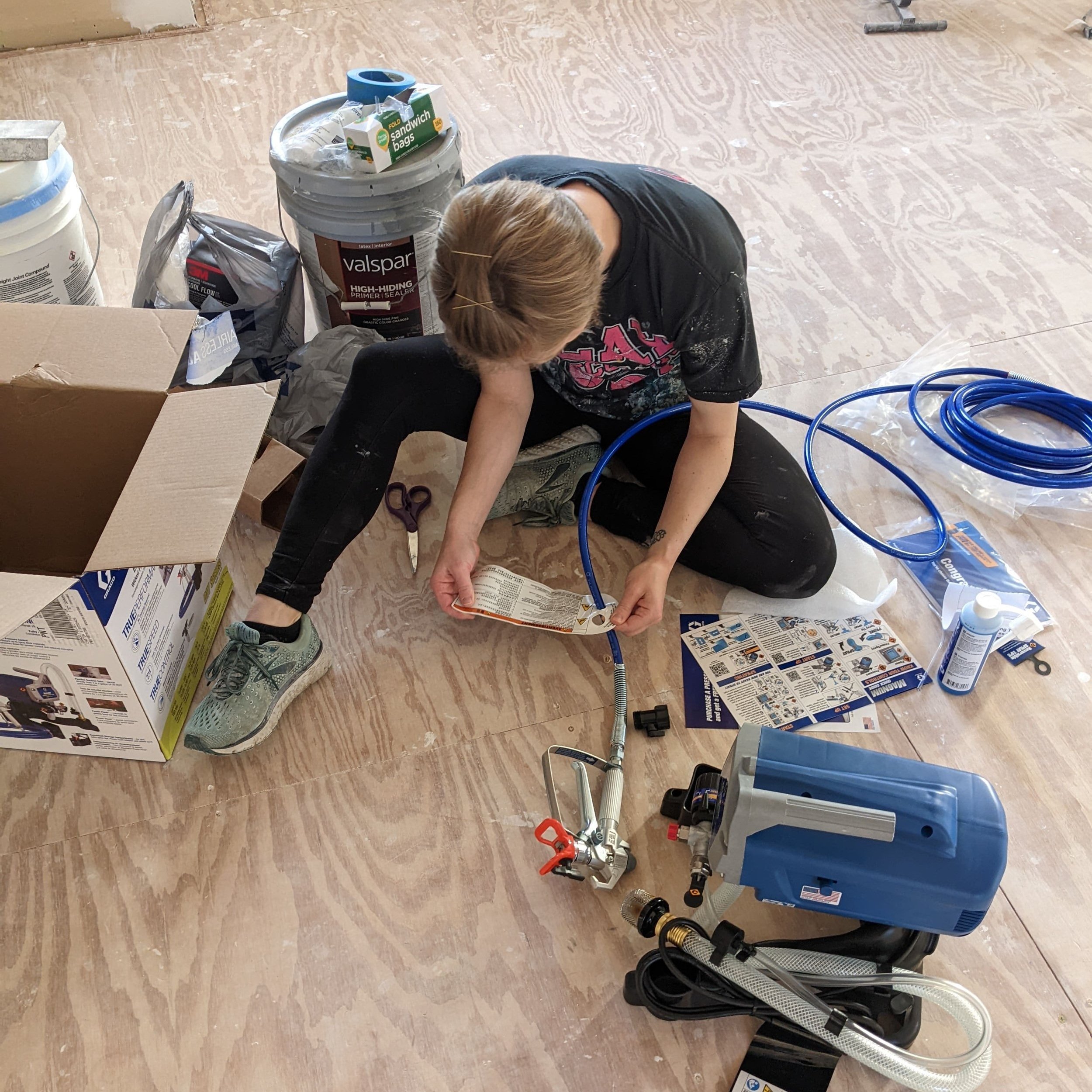Is it Better to Use a Brush and Roller or Paint Sprayer?
/Spraying vs Rolling Paint
Most people don’t love to paint. But I’m not most people.
I’ve said it once and I’ll say it again - I love painting. It’s my time to put on a good podcast, zone out, and let my mind wander - something I don’t give myself nearly enough time to do on the regular.
But when it came to painting our loft, I was intimidated. It’s a BIG room - around 900 sq. feet. The thought of rolling paint on the ceiling alone had me Googling local chiropractors in preparation for the aftermath. But then Lucius and I realized that with the loft completely empty, this would be a good opportunity to finally invest in a paint sprayer. So invest we did!
And now that the job is done, I’m excited to break down how using a paint sprayer compares to rolling paint, and to answer the question you might be asking, “Should I use a paint sprayer or a roller for that project?”.
Learning Curve
As an Amazon Associate, I earn from qualifying purchases. This post may contain affiliate links, meaning I receive commissions for purchases made through those links at no cost to you.
First up, let’s talk about the learning curve of each method.
Using a paint sprayer definitely took a bit of getting used to. Trying to figure out how far from the wall you need to be, how quickly to move for each pass, and finding the right intensity of the spray took some trial and error. For the first several passes, I had the intensity way too high and applied so much paint it started dripping. After some practice, though, I got the hang of it, got into a rhythm, and zoomed right along.
For reference, here’s the paint sprayer I own.
Rolling paint is so second nature to me at this point, at first, I wasn’t even thinking there was a learning curve. But then I remembered the first time I painted a room with a roller… (cue wavy lines)
I was a teenager painting my bedroom in the new house we just moved into. I chose a seafoam green color and was going to paint the ceiling. I remember paint raining upon my head, and the hardwood floors my dad was so excited about. Yikes.
Even while using a brush, it took a lot of practice before I was good enough to not use tape when cutting in anymore. This is my favorite paintbrush to use nowadays, btw.
Winner: Neither! Needless to say, each method comes with its own challenges and will take some getting used to in its own way.
Cost
At this point I’ve been painting interiors for years, but, as I mentioned above, it wasn’t until it was time to paint the loft that we decided to invest in a paint sprayer. The main reason for our hesitation is simple: cost. Paint sprayers can be expensive! Of course, there are tons of different tiers of pricing depending on the bells and whistles each paint sprayer has. But the initial investment definitely felt like, well, an investment.
By comparison, a paintbrush and roller are significantly cheaper. BUT over time those costs can add up. I reuse my brushes loads of times before I replace them, and I’ll get at least a few good runs out of a roller too. But inevitably, they need to be tossed at the risk of sacrificing my finished product.
Another aspect of cost to consider is that paint sprayers overall use quite a bit more paint. I saw a couple of resources mention they could use up to 33% more paint! Mo paint = mo money. Unfortunately, most of that paint ends up being dispersed into the air and drying into fine dust before it hits anything.
Winner: I have to give it to the tried and true roller and brush method.
Coverage
I’ve said it before, but no matter what the paint manufacturers tell you, when using a roller, you should ALWAYS apply at least two coats of paint. I know, it’s annoying and time-consuming, but I guarantee you’ll miss little spots here and there and overall won’t see the true color of your paint with one coat.
On the flip side, I was impressed with how well the coverage was when using my paint sprayer. The walls in the loft turned out great. I think the off-white paint was a close enough match to the white primer that any light areas aren’t noticeable. HOWEVER, just because the coverage looks good, doesn’t mean you can always get away with one coat. (I learned this the hard way.)
When I sprayed the ceiling (with black paint, mind you), it looked a little streaky but I assumed that was where there was more paint applied and it would even out after it dried. NOT THE CASE. Once the paint dried the streaks were, although less noticeable, still visible. At that point, I had already cleaned up my sprayer and packed it in for the day. Shortly thereafter, we installed flooring and moved furniture back into the room (like a couple of dummies).
I guess what I’m saying is that I get the best of both worlds in this room because I get to go back and roll a second coat of paint on the ceiling! (Jealous?)
Winner: I’m not sure if my ceiling debacle is because of my inexperience with spraying paint, or if that’s a common problem. But since my walls turned out fine, I have to say a paint sprayer will typically give you better coverage.
Finish
One thing I was pleasantly surprised about after using my paint sprayer was the finish. I didn’t expect the walls to be as smooth as a baby’s bottom, but they are!
By contrast, rollers can leave a slight texture, though it’s never been noticeable enough to bother me. I think it’s worth noting that at the end of the day, the smoother finish from spraying paint wouldn’t be the deciding factor in choosing a sprayer over a roller.
Unfortunately for me, I didn’t realize there would be a difference in the texture of the paint after rolling vs spraying. When I started to tape off the ceiling to spray the walls, the ceiling wasn’t cured enough, and pulled some paint off with it. I decided to stop taping and instead spray only the bottom half of the walls and roll the top half.
Of course, I didn’t think about the difference in texture between the two at the time. It’s a subtle, barely noticeable thing, but it bothers me since I know it’s there.
Winner: Paint sprayer takes the cake for this one
Versatility
The way I see it, there are two main arguments for versatility: texture and paint type.
Texture
Rollers come in various nap sizes so that you can paint various different textures of walls. The different naps can even help add texture to a wall if you want. BUT, depending on the type of texture, rolling might not be your best option. Take popcorn ceilings for example, which are known to shred a roller.
A paint sprayer, on the other hand, can get into all those nooks and crannies with no problem, but can’t add texture.
Paint Type
Painting our loft actually wasn’t the first time I had used a paint sprayer. Last summer, when I was working on our deck, I spent loads of time tediously taping off everything in preparation to spray it. But once I started, I only made it a few passes before the sprayer got clogged. Unbeknownst to me, because of the added texture, deck paint cannot be sprayed (at least with the sprayers I’ve used). That being said, I’m sure there are other types of paint that are inadvisable to spray.
Using a brush and roller, however, saved the day! Yes, brushing paint between each of the deck boards before rolling on paint was tedious, but it got the job done. And had I known beforehand that the sprayer wouldn’t work, I would have saved a ton of time NOT taping off everything surrounding the deck.
Winner: I’m calling this one a tie.
Set up and Teardown
The time to set up and teardown a paint sprayer is, in my opinion, the biggest argument against not using one - especially with a more heavy-duty paint sprayer like mine.
With a brush and a roller, you just grab them and go. But with a paint sprayer, you have to deal with putting it together, priming it, and then pretty much doing all that in reverse once you’re done. Not to mention covering anything you don’t want to be painted (including yourself).
Plus, switching colors with a paint sprayer is much more complicated because you have to deal with flushing out the whole system. Typically with a brush and roller, I’ll have several on-hand. When switching colors, I simply put the used item in a Ziploc bag until I’m ready to wash everything at once at the end.
Winner: This is an easy one - a paintbrush and roller wins hand’s down.
On that note…
Speed
While you can practically jump right in with a brush and roller, if you’re planning on using a paint sprayer you really have to prepare. Unless your room is completely empty (like mine was), you have to ensure that ANY exposed surface is covered. All of that prep work can take quite a bit of time.
On the flip side, the act of spraying a room is significantly faster than cutting in with a brush and rolling on two coats of paint. Painting the loft would have taken me several days with a roller and brush. While spraying the room still took a good amount of time, I was able to get it done in two (long) days total.
Winner: Total tie
The question you really want answered…
When it comes down to it, many of you are probably saying to yourselves, “Okay, okay, get to the point. When should I use a paint sprayer vs a roller?”. Well, lucky for you I’m here to give you the most wishy-washy answer I can: It depends!
But seriously, each painting project is going to have its own circumstances. Your best bet is to weigh the pros and cons I outlined above and determine on a case-by-case basis which method is best for that specific project. Or, pin the infographic below to reference later!
Are there any pros or cons for either method I missed? Let me know in the comments!
















